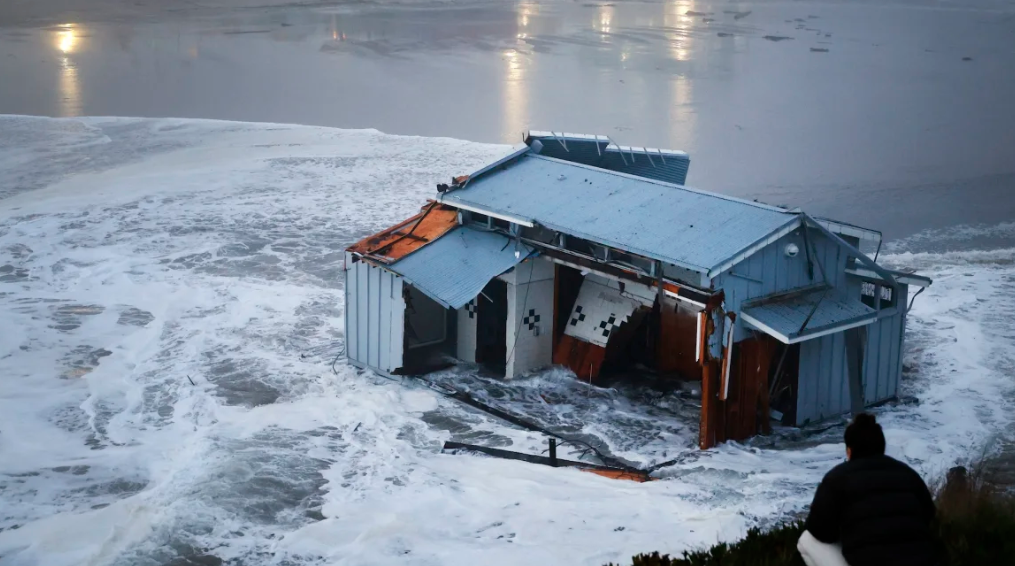Explore the Santa Cruz Wharf collapse during California’s recent storms, its environmental implications, and the urgent need for resilient infrastructure.
Santa Cruz Wharf Collapse: A Wake-Up Call Amidst California’s Severe Storms
California’s coastal communities have faced relentless storms in recent days, with one of the most striking incidents being the partial collapse of the iconic Santa Cruz Wharf. As heavy surf and high winds battered the region, the structural integrity of this historical landmark was tested like never before, leading to the collapse and injuries to three individuals who were thrown into the ocean.
This article delves into the incident, the environmental factors contributing to it, and the implications for California’s infrastructure amidst increasingly severe weather patterns.
What Happened at the Santa Cruz Wharf?
The Incident
On December 24, 2024, heavy surf conditions caused a section of the Santa Cruz Wharf to give way, sending three people into the ocean. Fortunately, they were rescued promptly with no fatalities reported. The collapse occurred during peak storm activity, as high winds and powerful waves battered the structure.
A Historical Landmark
The Santa Cruz Wharf, originally built in 1914, has been a cultural and economic staple of the area, hosting businesses, recreational activities, and tourism. However, its age and the severity of recent storms may have contributed to the damage.
Environmental Factors at Play
Severe Storm Activity
The collapse occurred amidst one of California’s most intense storm seasons in recent memory. Meteorologists attribute these conditions to a combination of El Niño and climate change, which have intensified storm patterns and coastal erosion.
Rising Sea Levels and Coastal Erosion
California’s coastline has been increasingly vulnerable due to rising sea levels and erosion. Structures like the Santa Cruz Wharf face amplified risks as waves and storm surges grow stronger.
Aging Infrastructure
Many of California’s coastal landmarks, including piers and wharves, were built decades ago and have not been upgraded to withstand modern climate challenges.
Implications and the Way Forward
Reevaluating Infrastructure Resilience
The incident highlights the urgent need to reassess and fortify California’s coastal infrastructure. Strengthening piers, seawalls, and other structures could mitigate damage from future storms.
Environmental Awareness and Preparedness
Events like the Santa Cruz Wharf collapse serve as a reminder of the importance of environmental awareness. Preparing for severe weather and understanding its long-term implications are crucial for coastal communities.
Community and Economic Impact
The wharf’s closure for repairs or potential rebuilding will likely have economic repercussions for Santa Cruz, disrupting businesses and tourism in the area.
Conclusion: A Call for Action
The Santa Cruz Wharf collapse is more than just a localized event—it’s a wake-up call for coastal cities facing the realities of climate change. As severe weather events become more frequent, the need for proactive measures to protect infrastructure, communities, and the environment is undeniable.
California must act swiftly to safeguard its iconic landmarks and ensure resilience against the challenges posed by a changing climate.
FAQ Section: Understanding the Santa Cruz Wharf Collapse
Q1: What caused the Santa Cruz Wharf to collapse?Heavy surf and strong winds during a severe storm caused a section of the wharf to collapse.
Q2: Were there any injuries in the incident?Yes, three individuals were thrown into the ocean during the collapse but were rescued without serious injuries.
Q3: How old is the Santa Cruz Wharf?The wharf was built in 1914, making it over a century old.
Q4: Is the collapse related to climate change?While the collapse was directly caused by the storm, the intensity of such weather events has been linked to climate change and rising sea levels.
Q5: What steps can be taken to prevent future incidents?Reinforcing aging infrastructure, implementing stricter building codes, and investing in coastal resilience projects are critical measures.
